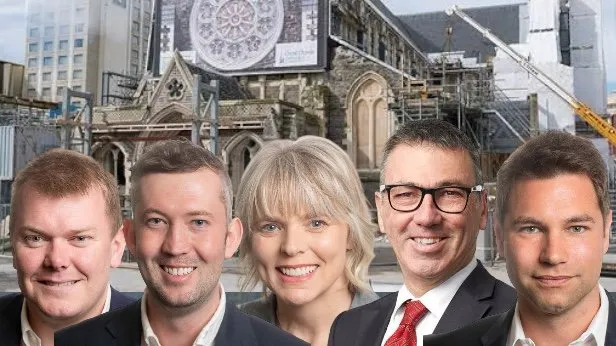Table of Contents
The Grampus
I recently received a lengthy questionnaire from the Christchurch City Council (CCC) about what the council and individuals could do to mitigate climate change and reduce our emissions and so forth. I was aware the CCC did have an investment in reducing climate change and that significant monies were being spent in this area. Accordingly, I wrote the following OIA request, interested in what I may find.
My questions were:
1. The total cost of CCC moneys being spent in relation to mitigation of climate change and emission reduction designed to reduce atmospheric CO2
2. The scientific basis that you use that confirms that we need to be concerned about the impact of ‘climate change’. This would of course include independent, fully referenced and peer reviewed literature that analyses real data and observations, not modelling.
To say I was gobsmacked was putting it mildly when I realised that one small city of barely 500,000 people has budgeted $318 million over the next 10 years, with a further one billion (with a ‘B’) on flood protection that may or may not be accentuated by rising sea levels.
I must say that I have no problem at all with feel-good projects, such as increased tree planting to reduce atmospheric pollution, but Christchurch has an average Air Quality Index of single figures and even today, which is still and calm and overcast, it is only 27 ppm. Compare this to the WHO Air Quality Standards that range from 0–66 (green and high quality) to 500+ (dark brown and toxic). We live in an oceanic westerly airflow having some of the least-polluted air on the planet so, while it is nice to beautify the city, these actions make zero difference in terms of emissions.
In contrast, most of Europe is currently 500+ppm, which is described as hazardous. I doubt there is much the CCC actually need do to reduce our already excellent air quality.
My second question was of course completely fudged and relied on info from various groups including the IPCC so in fact there was no answer that showed that real and actual data had been used in any analyses, as most government agencies rely solely on modelling.
So we have this one small city committing over one billion dollars toward something that will not happen in our lifetimes and not our children’s lifetimes, if ever.
The discussion of course is: do we simply put up with trillions of dollars spent worldwide to prevent something that is never going to be of significance? And, closer to home: what do we do when councils commit to such expenditure? We know that when people talk about emissions there are two distinct areas of discussion: actual particulate pollution, which is not good, or CO2, which is very good. We live on the edge of a carbon drought and frankly the more CO2 we can release into the atmosphere the better all round. Each year we get new greening on the planet of an area approximately the size of France. Poverty and droughts (unless deliberate and man-made) are reducing and most people are healthier and have access to far higher quality food than our parents’ generation.
Sadly, groups like city councils and their so-called experts are reluctant to stray very far from the narrative. On the other hand we, the ratepayers and electors, must keep holding them to account.
Oh, and by the way, New Zealand glaciers are not receding due to climate change, but rather we are going through a long period of reduced rainfall – more often than not due to a cooler atmosphere supporting less water vapour to fall as snow in the high alpine.
Council Response:
Responding to climate change (either reducing greenhouse gas emissions or growing resilience to natural hazards) is embedded throughout the work of the Council making it difficult to reflect a total amount spent on these activities. However, on Page 33 of the Council’s consultation document about the Draft 2024-34 Long-Term Plan the Council has identified significant work that directly contributes to our climate responses. It is worth noting that investments in climate related activities provides significant benefits to our community, such as health and wellbeing improvements related to active transport, air quality improvements, shade and shelter provided by trees and lower energy bills.
At a high level, we’re spending $318 million over 10 years on projects that have a direct impact on climate change mitigation:
Public transport – $101 million
Major cycleways – $199 million
Urban forest – $18 million. We’re spending $1 billion over 10 years on projects that directly help us adapt, and build our resilience:
The flood protection portfolio (excluding the Otakaro Avon River Corridor) – $525 million
The full Otakaro Avon River Corridor Programme – $490 million
For a breakdown of the full Council budget, please refer to the 2024-34 Long-Term Plan documents available on this webpage.
2. Where is our proof that climate change is occurring?
Council has legal responsibilities to consider the current and future social, economic and environmental wellbeing of its residents – this includes consideration of current and future risks such as those posed by natural hazards. Central Government has also placed responsibilities on councils through the Resource Management Act, National Emission Reduction Plan and National Adaptation Plan. Consequently, we are legally required to consider and plan for the impacts of climate change. The Intergovernmental Panel on Climate Change has concluded that human caused planetary warming is unequivocal. Central Government has provided guidance to New Zealand councils (such as this guide on sea level rise that clearly shows a rise in sea levels at 5 locations around New Zealand including Lyttelton) and we are following this advice. In New Zealand there are numerous physical records that provide evidence of a warming planet. The most clear example of this is the 33% loss of ice from New Zealand glaciers over the last 40 years. This information and other weather related information is collected and shared on this NIWA website.









